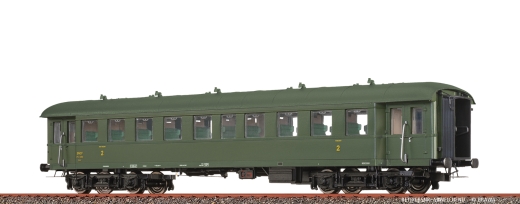Settings
Shipping country
Languages
- Products description
Products description
BRAWA 46184 - H0 express train carriage B9ti SNCF
Role model information
In the mid-1920s, the DRG began to significantly improve the travel comfort of its express and passenger train connections. In addition to the newly purchased two-axle vehicles, four-axle compartment cars were mainly used on long-distance routes (for example, there were accelerated passenger trains from Munich to Berlin). From 1928 onwards, several four-axle through cars with open crossings began to be tested, which were to be used in these services in the future. The test cars proved successful and from 1930 onwards over 1,000 B-BC and C4i in riveted construction were purchased. It was characteristic that the B section always had single-leaf doors, while the C section had double doors. When advances in welding technology could also be used for wagon construction, the tried-and-tested design had to be adapted. In 1935, three test cars each of the BC and C designs were purchased, which were followed by almost unchanged series production. Despite the weight savings, the welded cars had fewer seats than their riveted predecessors because the DRG made the passenger compartments more spacious. There were also larger windows and their lower edge, which was 150 mm lower, offered “Steppkes” in particular a better field of vision of the railway operations, which were not yet dominated by soundproof walls. In the welded version, over 1,000 C and 145 BC cars were built in six years, before progress made further improvements possible in the form of the apron cars. The war scattered the express train cars across half of Europe; there were larger stocks outside the German railways, including at the ÖBB, SNCF and PKP. At the DB and DR, the cars remained indispensable in district traffic until the end of the 1970s and were over forty years old. They were also used internationally until the 1960s, from Scandinavia to the Balkans. There were numerous conversions, including sleeping, dining, buffet and half-luggage cars. For its anniversary in 1985, the DB refurbished a complete train consisting of several different types of express train cars. Unfortunately, these wagons are now scattered across several locations and only a few of them are still operational.
Model details
Epoch-appropriate design differences
Exactly reproduced Görlitz III light bogies
With four-way suspension
Exactly reproduced frame with many attached individual parts
Prepared for interior lighting
Multi-part interior, multi-colored
Individual seats
Short coupling kinematics
Three-point bearing
Metal axle bearing
Replica of the roof rivets
Precisely fitted windows
Metal wheels
Complete reproduction of the brake system
Exemplary large dimensions of the windows
Prototypical with rubber bead transitions
Technical details
Length over buffers: 239.8 mm
Interior: built-in
Interior lighting: prepared for BRAWA order no. 2212
Short coupling kinematics: installed
AC wheelset replacement: possible
AC wheelset: BRAWA order no. 2188
AC grinder: BRAWA order no. 2222
Characteristics:
| Manufacturer: | BRAWA |
| Item number: | 46184 |
| number of pieces: | 1 piece |
| EAN: | 4012278461847 |
| track: | H0 |
| scale: | 1:87 |
| model series: | Passenger carriage express train carriage group 36 |
| Company number: | 14913 |
| Railway company: | SNCF |
| country: | FR |
| epoch: | III |
| Wheel set replacement: | yes - possible |
| AC wheelset: | BRAWA order no. 2188 |
| grinder: | BRAWA order no. 2222 |
| Electricity system: | DC |
| operation mode: | DC analogue |
| Length over buffers: | 239.8mm |
| coupling: | NEM 362 shaft with KK kinematics |
| Interior decoration: | equipped with interior furnishings |
| Interior lighting: | prepared for BRAWA order no. 2212 |
| Age recommendation: | 14 years and older |
| WEEE no.: | DE14862574 |
Information according to GPSR
Manufacturer contact details
BRAWA Artur Braun Modellspielwarenfabrik GmbH & Co. KG
Uferstraße 24-30
73630 Remshalden
Deutschland
Website: www.brawa.de
E-mail addres: info@brawa.de
Telephone: +49 (0)71 51-979 35-0
Fax: +49 (0) 71 51-746 62
For further information, please visit the homepage of this product.
This Product was added to our catalogue on 02/03/2024.
Last viewed:



















